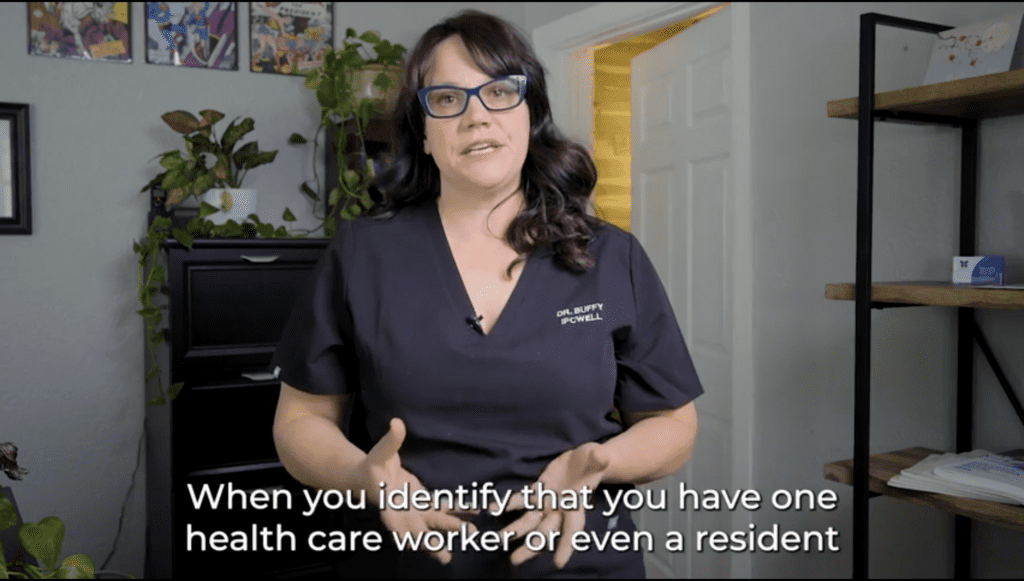A COVID-19 outbreak indicates potentially extensive transmission within a setting or organization according to the Centers for Disease Control and Prevention (CDC). In today’s world, a COVID-19 outbreak can be a life-or-death situation in a nursing home and calls for immediate attention. When you have one healthcare professional (HCP) or even a resident that’s positive for COVID-19, this is considered an outbreak per CMS.
In the event of an outbreak, the first step is to contact your county health department to partner with them; the CDC has a Public Health Professionals Gateway with contacts for public health contacts in your area that include senior health officials, state, local, and territorial health departments, and tribes and Indigenous organizations. Contacting public health officials is essential to collaboratively work together to mitigate the spread of this infection within the rest of your community.
The second step is to start testing for COVID-19. On September 10th, 2021, the CDC updated their criteria for outbreak cohorting and testing. Facilities have the opportunity to either do contract tracing, or broad-based testing and can choose what works best in their situation. For example, if an HCP was on unit A and only cared for the residents in that hallway without encountering any other residents in the building, there is an option to do contact tracing and identify every resident and every staff member that the HCP encountered; these are the individuals that would need testing for COVID-19. Conversely, broad-based testing might be best if there’s an outbreak, especially if there’s a lot of contact or unknown contact.
It is important to have a testing plan in place for testing both residents and HCPs for SARS-CoV-2. Asymptomatic HCPs with a higher-risk exposure and residents with close contact with someone with SARS-CoV-2 infection, regardless of vaccination status, should have a series of two viral tests for COVID-19. In these situations, testing is recommended immediately (but not earlier than 2 days after the exposure) and, if negative, again 5-7 days after the exposure. Testing is not recommended for people who have had COVID-19 in the last 90 days if they remain asymptomatic, including if they have had close contact or higher-risk exposure; this is because some people may be non-infectious but have a detectable virus from their prior infection during this period. Please keep in mind that COVID-19 can spread asymptomatically, therefore if a HCP has COVID-19, they could be spreading it for days before they ever test positive or have symptoms. This demonstrates the importance of testing right away. In addition, testing needs to be conducted every three to seven days of all the staff and residents. This is especially important because of the time it takes from exposure to getting COVID or even testing positive.
If you have additional positives, specifically in residents, the third step is to place them in quarantine to mitigate the spread of this infection. The location of the COVID-19 care unit should ideally be physically separated from other rooms or units housing residents without confirmed SARS-CoV-2 infection. This could be a dedicated floor, unit, or wing in the facility or a group of rooms at the end of the unit that will be used to cohort residents infected with COVID-19. An increase of monitoring of residents with suspected or confirmed SARS-CoV-2 should be done including assessment of symptoms, vital signs, oxygen saturation, and a respiratory exam.
Thank you to all the healthcare heroes out there keeping our nursing home residents safe during this new wave of COVID-19 cases around the country.
#infectioncontrol #diseasecontrol #nursinghomeinfectioncontrol #nursinghomeIPC #IPC #infectioncontrolspecialist #diseasecontrolspecialist #diseasepreventon #covidcontrol #nursinghomeIPC #longtermcareIPC #cmssurvey #cmsreport #2567remediation #antibioticstewardship #NHSNimplementation #infectioncontroltraining #infectioncontrolnurse #testingrequirements #truthabouttesting

